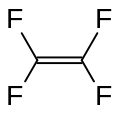Tetrafluoroethylene
Tetrafluoroethylene (TFE) is a fluorocarbon with the chemical formula C2F4. It is the simplest perfluorinated alkene. This gaseous species is used primarily in the industrial preparation of polymers.
| |||
| Names | |||
|---|---|---|---|
| IUPAC name
tetrafluoroethene | |||
| Other names
perfluoroethylene TFE | |||
| Identifiers | |||
3D model (JSmol) |
|||
| ChEBI | |||
| ChEMBL | |||
| ChemSpider | |||
| ECHA InfoCard | 100.003.752 | ||
| KEGG | |||
PubChem CID |
|||
| UNII | |||
CompTox Dashboard (EPA) |
|||
| |||
| |||
| Properties | |||
| C2F4 | |||
| Molar mass | 100.02 g/mol | ||
| Appearance | Colorless gas | ||
| Odor | Odorless | ||
| Density | 1.519 g/cm3 at -76 °C | ||
| Melting point | −142.5 °C (−224.5 °F; 130.7 K) | ||
| Boiling point | −76.3 °C (−105.3 °F; 196.8 K) | ||
| Hazards | |||
| NFPA 704 (fire diamond) | |||
Except where otherwise noted, data are given for materials in their standard state (at 25 °C [77 °F], 100 kPa). | |||
| Infobox references | |||
Properties
Tetrafluoroethylene is a colorless, odorless gas. Like all unsaturated fluorocarbons, it is susceptible to nucleophilic attack. It is unstable towards decomposition to carbon and carbon tetrafluoride (CF
4) and prone to form explosive peroxides in contact with air.[2]
Industrial use
Polymerization of tetrafluoroethylene produces polytetrafluoroethylene (PTFE) polymers such as Teflon and Fluon. PTFE is one of the two fluorocarbon resins composed wholly of fluorine and carbon. The other resin composed purely of carbon and fluorine is the copolymer of TFE with typically 6–9% hexafluoropropene (HFP), which is known as FEP (fluorinated ethylene propylene copolymer). TFE is also used in the preparation of numerous copolymers that also include hydrogen and/or oxygen, including both fluoroplastics and fluoroelastomers. Typical TFE-based fluoroplastics include ETFE, the alternating 1:1 copolymer with ethylene, and PFA, which is a random copolymer similar to FEP but with a minor amount of a perfluoroalkyl vinyl ether (PAVE) rather than HFP. DuPont uses primarily perfluoro(methylvinylether), whereas Daikin uses primarily perfluoro(propylvinylether) in manufacturing PFA. There are numerous other fluoropolymers that contain tetrafluoroethylene, but usually not at greater than 50% by weight.
Manufacture
TFE is manufactured from chloroform.[3] Chloroform is fluorinated by reaction with hydrogen fluoride to produce chlorodifluoromethane (R-22). Pyrolysis of chlorodifluoromethane (at 550-750 °C) yields TFE, with difluorocarbene as an intermediate.
- CHCl3 + 2 HF → CHClF2 + 2 HCl
- 2 CHClF2 → C2F4 + 2 HCl
Alternatively, it can be prepared by pyrolysis of fluoroform:
- 2 CHF3 → C2F4 + 2 HF
Laboratory methods
The reverse polymerization reaction – vacuum pyrolysis of PTFE at 650–700 °C (1,200–1,290 °F) in a quartz vessel – is a convenient laboratory synthesis of TFE. The PTFE polymer cracks, and at a pressure below 5 Torr (670 Pa) exclusively C2F4 is obtained. At higher pressures the product mixture contains hexafluoropropylene and octafluorocyclobutane.[4]
Safety
The main hazard associated with TFE is that of explosion, especially if oxygen is present. TFE reacts with oxygen at low temperatures to form an explosive oxide,[2] the detonation of which is usually sufficient to trigger explosive decomposition of TFE to C and CF4.[5] Explosions can also be caused by adiabatic compression If pressurized TFE is allowed into a vessel/pipework at a lower pressure as the atmosphere in the vessel is compressed by the TFE, it may become hot enough to detonate it. This has been known to cause explosions.[6] In industry, pipework is flushed with pressurized nitrogen, before the introduction of TFE, both to exclude oxygen and prevent adiabatic compression.
TFE is an alkylating agent, albeit a weak one, and as such is expected to be a carcinogen. LD50(rat, inhalation) = 40000 ppm.[7]
Health Effects
The International Agency for Research on Cancer classifies TFE as probably carcinogenic to humans based on animal studies.[8]
References
- http://www.nmsu.edu/safety/programs/chem_safety/NFPA-ratingS-Z.htm
- Gozzo, F.; Camaggi, G. (January 1966). "Oxidation reactions of tetrafluoroethylene and their products—I". Tetrahedron. 22 (6): 1765–1770. doi:10.1016/S0040-4020(01)82248-1.
- Siegemund, Günter; Schwertfeger, Werner; Feiring, Andrew; Smart, Bruce; Behr, Fred; Vogel, Herward; McKusick, Blaine (2002). "Fluorine Compounds, Organic". Ullmann's Encyclopedia of Industrial Chemistry. Weinheim: Wiley-VCH. doi:10.1002/14356007.a11_349.
- R. J. Hunadi & K. Baum (1982). "Tetrafluoroethylene: A Convenient Laboratory Preparation". Synthesis. 39: 454. doi:10.1055/s-1982-29830.
- "The Explosive Decomposition of Tetrafluoroethylene: Large Scale Tests and Simulations | Request PDF". ResearchGate. Retrieved 2018-11-01.
- Reza, Ali; Christiansen, Erik (March 2007). "A case study of a TFE explosion in a PTFE manufacturing facility". Process Safety Progress. 26 (1): 77–82. doi:10.1002/prs.10174.
- NIH Substance Profile for TFE
- "TETRAFLUOROETHYLENE" (PDF). International Agency for Research on Cancer. Retrieved 20 May 2020.
External links
- National Toxicology Program Chemical Repository
- Tetrafluoroethylene, hexafluoropropylene and vinylidene fluoride terpolymer -- aka THV, melt-processable members of the fluorocarbon family
- Sleeuwenhoek, Anne; Cherrie, John (2012). "Exposure assessment of tetrafluoroethylene and ammonium perfluorooctanoate 1951-2002". Journal of Environmental Monitoring.


